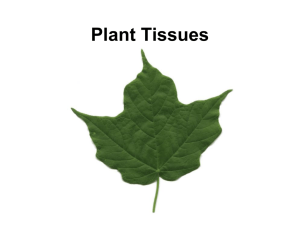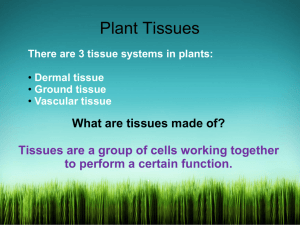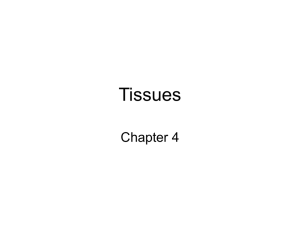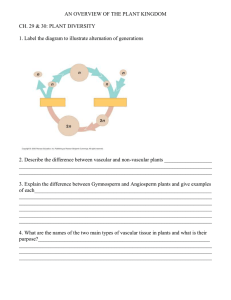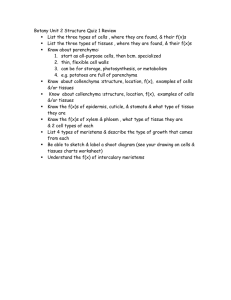PLANT STRUCTURE CELLS AND TISSUES
advertisement
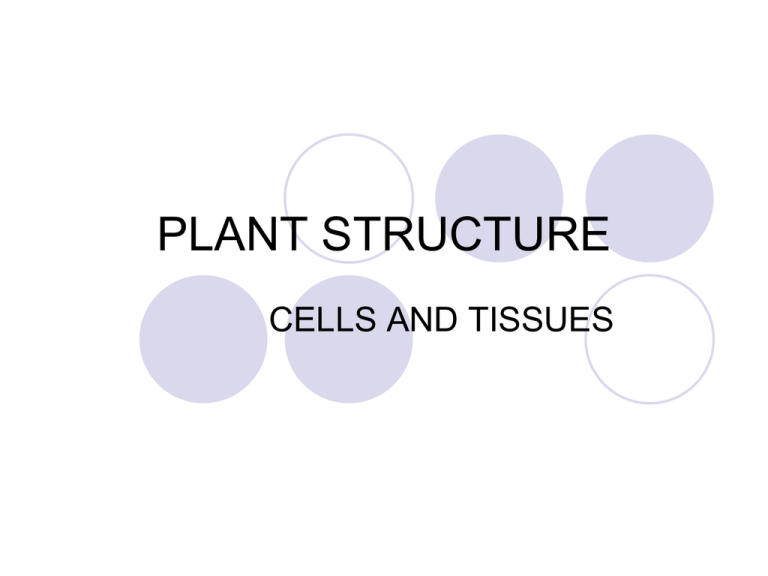
PLANT STRUCTURE CELLS AND TISSUES External Structure Morphology The study or science of the form, structure, and development of plants Internal Structure Anatomy A branch of morphology that deals with the structure of organisms; The study of body structures Histology The science that deals with the microscopic structure of plant or animal tissues Major Plant Classes Gymnosperms narrow-leaved, evergreen trees Angiosperms broad-leaved, flowering plants Angiosperm Subclasses Monocotyledons embryo has one cotyledon Dicotyledons embryo has two cotyledons Life Cycle of Corn – A Monocot Germination “awakening of the embryo” Water Radicle – primary root Plumule – primary shoot Coleorhiza – protective sheath for radical Coleoptile – protective sheath for plumule Maturing Corn Plant Adventitious roots a.k.a. anchor, brace, or prop roots grow from shoot axis (not the radical) add support Maturing Corn Plant Flowers Reproductive structures Female – pistillate form ears of corn Male – staminate form tassels Pollination and Fertilization Pollen from the mature tassels fall upon the silks (pistillate filaments) Fertilization occurs when the mature pollen grains release sperm that ultimately fertilize the ovaries Fruit Formation Fertilized ovaries develop into fruit Caryopsis fruit enclosing true seed Mature, dry fruit (kernels) harvested, stored, and planted when conditions are favorable for growing CELL FUNCTIONS o Manufacture, transport, store food o Uptake and transport water and nutrients o Structure/support o Suppress water loss o Divide/form new cells Differentiated cells form tissues and tissues form organs CELL COMPONENTS oCell membrane oCell wall o3 layers: oPrimary Cell Wall oSecondary Cell Wall oMiddle lamella CELL COMPONENTS Protoplast Living portion of cell Surrounded by cell plasma membrane Contains: cytoplasm endoplasmic reticulum ribosomes plastids mitochondria dictyosomes (golgi bodies) microtubules glyoxysomes lysosomes vacuoles nucleus 3 major permanent cells: parenchyma collenchyma sclerenchyma CELL PROCESSES - Cell division/growth Specific areas are active: Root tips, stem tips (apical) Cambium (dicots) Intercalary Meristem (monocots) - Enlargement and Differentiation forms Tissues BASIC KINDS OF TISSUES Meristematic - actively dividing cells - differentiate into other tissues and organs Permanent - develops from meristematic - differentiated fully TISSUES - Organized groups of cells with common origin and function may be: simple (one cell type) complex (two or more cell types) - Simple e.g. – epidermis, parenchyma, sclerenchyma, collenchyma, and cork - Complex e.g. – xylem, phloem 4 tissue systems: meristematic vascular dermal ground (fundamental) Meristematic Tissue specialized regions of active cell division - apical meristems (primary growth) - axillary buds (shoot’s insurance policy) - lateral meristems (secondary growth) - intercalary meristems (grasses) Vascular Tissue composed of two types of compound tissues: xylem (conducts water/minerals up from roots) phloem (conducts food throughout plant) Small “groups” of xylem and phloem called: Vascular Bundles xylem forms to inside phloem forms to outside Fibers (sclerenchyma) often form next to vascular bundles Dermal Tissue outer cell layer in young stems, roots, and leaves variations: root hairs multiple epidermis cutin (waxy substances; not on roots) replaced in older portions of roots/stems by bark Ground (fundamental) Tissue all tissues under epidermis not vascular or meristematic constitutes most of the primary body of a plant three kinds of cells: parenchyma, collenchyma, sclerenchyma STEM ANATOMY Epidermis - usually single layer - protects stem - usually cutinized - porous STEM ANATOMY (cont) Cortex - surrounds vascular bundles - surrounded by epidermis Vascular Cambium - produces secondary growth in dicots only - increases stem diameter Woody Stems (dicots only) – bark formed from vascular cambium outward STEM ANATOMY (cont) Cortex - beneath epidermis - encircles inner vascular tissue - comprised of: parenchyma collenchyma sclerenchyma STEM ANATOMY (cont) Vascular system *consists of: - pericycle - phloem - vascular cambium - xylem - pith rays - pith *inclusion and arrangement varies among plant groups Root Anatomy Root hairs - major site of water/nutrient absorption - located in zone of cell maturation - extensions of epidermal cells Lateral (secondary roots) - form near but behind root hair zone - from cells of pericycle; meristematic - forms apex; pushes through endodermis, cortex, epidermis LEAVES Initiated by apical shoot meristem Monocots vs Dicots Monocots have strap-shaped leaves with parallel veins interconnected Dicots have broader blades with veins arranged in the shape of a net LEAVES (cont) corn (Zea mays) a monocot leaf showing parallel venation of the major veins LEAVES (cont) Dicot Leaf from: yellow poplar (tulip tree) (Liriodendron tulipifera) LEAVES (cont) Veins contain sheaths of vascular bundles (xylem and phloem elements) This is a photomicrograph of dicot venation LEAVES (cont) Palisade and Spongy Mesophyll cells surround these veins Palisades – major photosynthesis Spongy – major gas exchange Tepals Tepals are elements of the perianth, or outer part of a flower, which include the petals or sepals. The term tepal, derived from a combination of the words 'petal' and 'sepal,' is usually used when all segments of the perianth are of similar shape and color, or undifferentiated. When different types of organs can be distinguished, they are referred to as petals and sepals. (source: Wikipedia) A lilium flower showing the tepals: the inner three are petals and the outer three are sepals.
